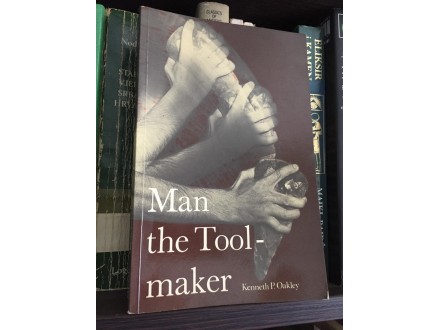MAN The TOOL - MAKER Kenneth P. Oakley / Arheologija
| Cena: |
| Želi ovaj predmet: | 2 |
| Stanje: | Polovan bez oštećenja |
| Garancija: | Ne |
| Isporuka: | BEX Pošta DExpress Post Express Lično preuzimanje |
| Plaćanje: | Tekući račun (pre slanja) Ostalo (pre slanja) Pouzećem Lično |
| Grad: |
Novi Sad, Novi Sad |
ISBN: Ostalo
Godina izdanja: .
Jezik: Engleski
Autor: Strani
Retko u ponudi
Odlično stanje
Kenneth P. Oakley
ilustrovano
Kenneth Page Oakley (7 April 1911 – 2 November 1981) was an English physical anthropologist, palaeontologist and geologist.
Oakley, known for his work in the Fluorine absorption dating of fossils by fluorine content,[1][2] was instrumental in the exposure[3] of the Piltdown Man hoax in the 1950s.
Oakley was born and died in Amersham, Buckinghamshire.
Contents
1 Education
2 Career
2.1 Publications
2.1.1 Other Publications Contributed to by Oakley
2.2 Exposure of Piltdown Man Hoax
3 References
Education[edit]
Oakley`s early education took place at the Grammar School at Amersham. As a young man he attended University College School, Hampstead, and then University College School, London. The latter is where he earned both his BSc as a major in anthropology and geology, and his PhD in the same field upon his completion of the program in 1938 when he was 27 years old.[4]
Career[edit]
Publications[edit]
Kenneth Oakley authored and contributed to several publications that developed the field of human evolution over the course of his life. One of these publications is the novel Man the Tool-Maker (1972) in which he thoroughly outlines the discoveries of pre-hominin and hominin tool use. Oakley does so by walking the reader through the historical background of about the previous conceptions of evolution, why tool use may have started, various tool compositions and purposes as discovered through fossils, and how tool use may have influenced the development of unique cultures. Oakley also includes several illustrations ranging from diagrams of how tools may have been used and actual images of fossilized tools as they have changed over time. Man the Tool-Maker has been republished several times since its initial publication in 1949 for a total of six separate editions by 1976.[5]
Another source that Oakley contributed to is the Catalogue of Fossil Hominids Part III: Americas, Asia, Australasia which he, Bernard Grant Campbell, and Theya Ivitsky Molleson all edited. This catalog, including Part I: Africa and Part II: Europe, organized all the identifying information of the hominids that had been discovered until that time in the late 1960s and early 1970s, including where they were discovered, the key features of the specimen, and their archeological contexts. Oakley was tasked with providing confirmation of the geological and absolute ages of the specimens, since that was considered his speciality.[6]
Other Publications Contributed to by Oakley[edit]
Piltdown man, Bobbs-Merrill, 1955
The succession of life through geological time, British Museum, 1967
Frameworks for dating fossil man, Weidenfeld & Nicolson; 3rd ed, 1969
Catalogue of Fossil Hominids: Africa, British Museum, 1977
Relative dating of the fossil hominids of Europe, British Museum, 1980
Exposure of Piltdown Man Hoax[edit]
In November 1953 Oakley, along with Drs. J. S. Weiner and W. E. le Gros Clark published The Solution of the Piltdown Problem in the Bulletin of The British Museum of Natural History: Geology Department. This publication provided the discovered evidence that proved the `Piltdown Man`, a skull that was initially deemed a new species and potential `missing link` called Eoanthropus dawsoni that had been discovered in 1913 by archeologist Charles Dawson, was in fact a hoax. Through a complete re-analysis of the specimen`s teeth abrasion, fluorine content, nitrogen content, and coloring, Oakley and his colleagues concluded that the skull fragments were not of one specimen. Instead, it appeared that the skull was a fabrication produced out of a modern ape mandible that had been skillfully fused to the cranial fragments of another species.[7]
This discovery by Oakley and his colleagues resulted in a vital reconstruction of the existing fossil record such that Eoanthropus dawsoni was removed, and proper research for other evidence of human evolution in other parts of the world could be encouraged.
antropologija razvitak čoveka sociologija arheološka nalazišta istraživanja poreklo alati tvorac alata čovek
International shipping
Paypal only
(Države Balkana: Uplata može i preko pošte ili Western Union-a)
1 euro = 117.5 din
For international buyers please see instructions below:
To buy an item: Click on the red button KUPI ODMAH
Količina: 1 / Isporuka: Pošta / Plaćanje: Tekući račun
To confirm the purchase click on the orange button: Potvrdi kupovinu (After that we will send our paypal details)
To message us for more information: Click on the blue button POŠALJI PORUKU
To see overview of all our items: Click on Svi predmeti člana
Ako je aktivirana opcija besplatna dostava, ona se odnosi samo na slanje kao preporučena tiskovina ili cc paket na teritoriji Srbije.
Poštarina za knjige je u proseku 225 dinara, u slučaju da izaberete opciju plaćanje pre slanja i slanje preko pošte. CC paket je 340 dinara. Postexpress i kurirske službe su skuplje ali imaju opciju plaćanja pouzećem. Ako nije stavljena opcija da je moguće slanje i nekom drugom kurirskom službom pored postexpressa, slobodno kupite knjigu pa nam u poruci napišite koja kurirska služba vam odgovara.
Ukoliko još uvek nemate bar 10 pozitivnih ocena, ili imate negativnih ocena, zbog nekoliko neprijatnih iskustava, molili bi vas da nam uplatite cenu kupljenog predmeta unapred.
Novi Sad lično preuzimanje (pored Kulturne stanice Eđšeg) ili svaki dan ili jednom nedeljno zavisno od lokacije prodatog predmeta (jedan deo predmeta je u Novom Sadu, drugi u kući van grada).
Našu kompletnu ponudu možete videti preko linka
https://www.kupindo.com/Clan/H.C.E/SpisakPredmeta
Ukoliko tražite još neki naslov koji ne možete da nađete pošaljite nam poruku možda ga imamo u magacinu.
Pogledajte i našu ponudu na limundu https://www.limundo.com/Clan/H.C.E/SpisakAukcija
Slobodno pitajte šta vas zanima preko poruka. Preuzimanje moguce u Novom Sadu i Sremskoj Mitrovici uz prethodni dogovor. (Većina knjiga je u Sremskoj Mitrovici, manji broj u Novom Sadu, tako da se najavite nekoliko dana ranije u slucaju ličnog preuzimanja, da bi knjige bile donete, a ako Vam hitno treba neka knjiga za danas ili sutra, obavezno proverite prvo preko poruke da li je u magacinu da ne bi doslo do neprijatnosti). U krajnjem slučaju mogu biti poslate i poštom u Novi Sad i stižu za jedan dan.
U Novom Sadu lično preuzimanje na Grbavici na našoj adresi ili u okolini po dogovoru. Dostava na kućnu adresu u Novom Sadu putem kurira 350 dinara.
Slanje nakon uplate na račun u Erste banci (ukoliko ne želite da plaćate po preuzimanju). Poštarina za jednu knjigu, zavisno od njene težine (do 2 kg), može biti od 170-264 din. Slanje vise knjiga u paketu težem od 2 kg 340-450 din. Za cene postexpressa ili drugih službi se možete informisati na njihovim sajtovima.
http://www.postexpress.rs/struktura/lat/cenovnik/cenovnik-unutrasnji-saobracaj.asp
INOSTRANSTVO: Šaljem po dogovoru, ili po vašim prijateljima/rodbini ili poštom. U Beč idem jednom godišnje pa ako se podudare termini knjige mogu doneti lično. Skuplje pakete mogu poslati i po nekom autobusu, molim vas ne tražite mi da šaljem autobusima knjige manje vrednosti jer mi odlazak na autobusku stanicu i čekanje prevoza pravi veći problem nego što bi koštala poštarina za slanje kao mali paket preko pošte.
Ukoliko kupujete više od jedne knjige javite se porukom možda Vam mogu dati određeni popust na neke naslove.
Sve knjige su detaljno uslikane, ako Vas još nešto interesuje slobodno pitajte porukom. Reklamacije primamo samo ukoliko nam prvo pošaljete knjigu nazad da vidim u čemu je problem pa nakon toga vraćamo novac. Jednom smo prevareni od strane člana koji nam je vratio potpuno drugu knjigu od one koju smo mu mi poslali, tako da više ne vraćamo novac pre nego što vidimo da li se radi o našoj knjizi.
Ukoliko Vam neka pošiljka ne stigne za dva ili tri dana, odmah nas kontaktirajte za broj pošiljke kako bi videli u čemu je problem. Ne čekajte da prođe više vremena, pogotovo ako ste iz inostranstva, jer nakon određenog vremena pošiljke se vraćaju pošiljaocu, tako da bi morali da platimo troškove povratka i ponovnog slanja. Potvrde o slanju čuvamo do 10 dana. U 99% slučajeva sve prolazi glatko, ali nikad se ne zna.
Ukoliko uvažimo vašu reklamaciju ne snosimo troškove poštarine, osim kada je očigledno naša greška u pitanju.
Predmet: 72727973











